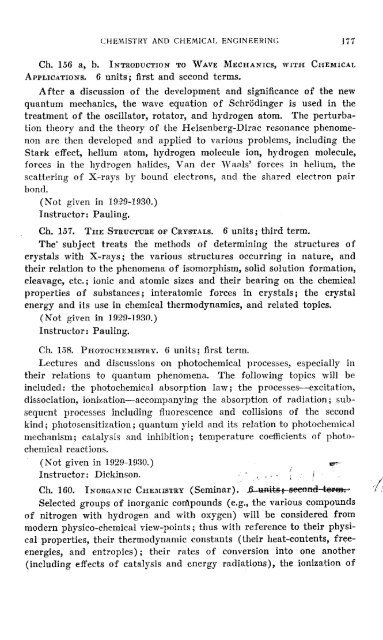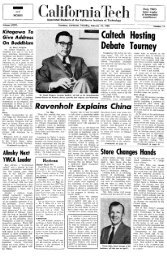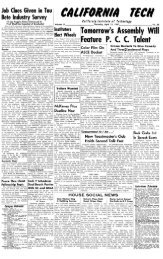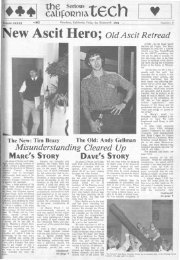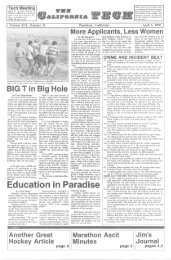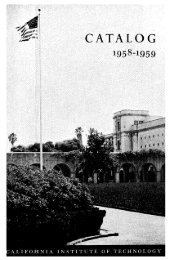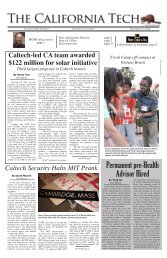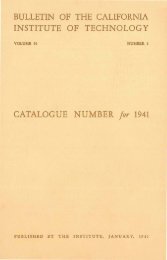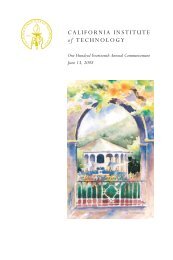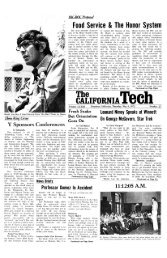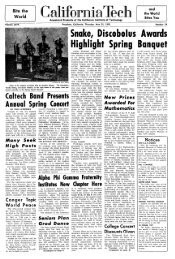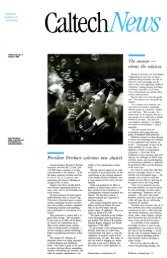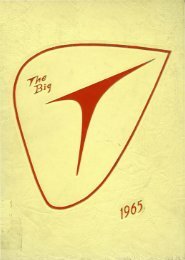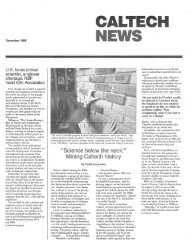Copy 2 of DOC - Caltechcampuspubs - California Institute of ...
Copy 2 of DOC - Caltechcampuspubs - California Institute of ...
Copy 2 of DOC - Caltechcampuspubs - California Institute of ...
You also want an ePaper? Increase the reach of your titles
YUMPU automatically turns print PDFs into web optimized ePapers that Google loves.
CHEMISTRY AND CHEMICAL ENGINEERING 177<br />
Ch. 156 a, b. INTRODUCTION TO WAVE MECHANICS, wrrH CHEMICAL<br />
ApPLICATIONS. 6 units; first and second terms.<br />
After a discussion <strong>of</strong> the development and significance <strong>of</strong> the new<br />
quantum mechanics, the wave equation <strong>of</strong> Schrodinger is used in the<br />
treatment <strong>of</strong> the oscillator, rotator, and hydrogen atom. The perturbation<br />
theory and the theory <strong>of</strong> the Heisenberg-Dirac resonance phenomenon<br />
are then developed and applied to various problems, including the<br />
Stark effect, helium atom, hydrogen molecule ion, hydrogen molecule,<br />
forces in the hydrogen halides, Van del' 'Wanls' forces in helium, the<br />
scattering <strong>of</strong> X-rays by bound electrons, and the sharpd electron pair<br />
bond.<br />
(Not given in 1929-1930.)<br />
Instructor: Pauling.<br />
Ch. 157. THE STRUCTURE OF CRYSTALS. 6 units; third term.<br />
The' subject treats the methods <strong>of</strong> determining the structures <strong>of</strong><br />
crystals with X-rays; the various structures occurring in nature, and<br />
their relation to the phenomena <strong>of</strong> isomorphism, solid solution formation,<br />
cleavage, etc.; ionic and atomic sizes and their bearing on the chemical<br />
properties <strong>of</strong> substances; interatomic forces in crystals; the crystal<br />
energy and its use in chemical thermodynamics, and related topics.<br />
(Not given in ] 9529-1930.)<br />
Instrudor: Pauling.<br />
Ch. 158. PHOTOCHEMISTRY. 6 units; first term.<br />
Lectures and discussions on photochemical processes, especially in<br />
their relations to quantum phenomena. The following topics will bc<br />
included: the photochemical absorption law; the processes-excitation,<br />
dissociation, ionization-accompanying the absorption <strong>of</strong> radiation; subsequent<br />
processes including fluorescence and collisions <strong>of</strong> the second<br />
kind; photosensitization; quantum yield and its relation to photochemical<br />
mechanism; catalysis and inhibition; temperature coefficients <strong>of</strong> photochemical<br />
reactions.<br />
(Not given in 1929-1930.)<br />
Instructor: Dickinson.<br />
I<br />
Ch. 160. INORGANIC CHEMISTRY (Seminar). .6 anita! seeond tanH. '! '<br />
Selected groups <strong>of</strong> inorganic compounds (e.g., the various compounds<br />
<strong>of</strong> nitrogen with hydrogen and with oxygen) will be considered from<br />
modern physico-chemical view-points; thus with reference to their physical<br />
properties, their thermodynamic constants (their heat-contents, freeenergies,<br />
and entropies); their rates <strong>of</strong> conversion into one another<br />
(including effects <strong>of</strong> catalysis and energy radiations), the ionization <strong>of</strong>


